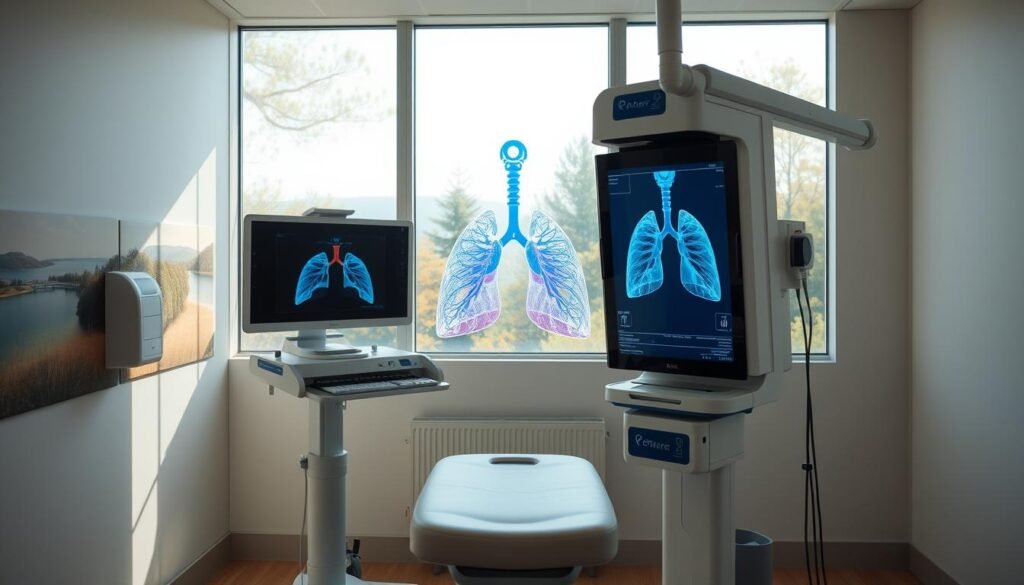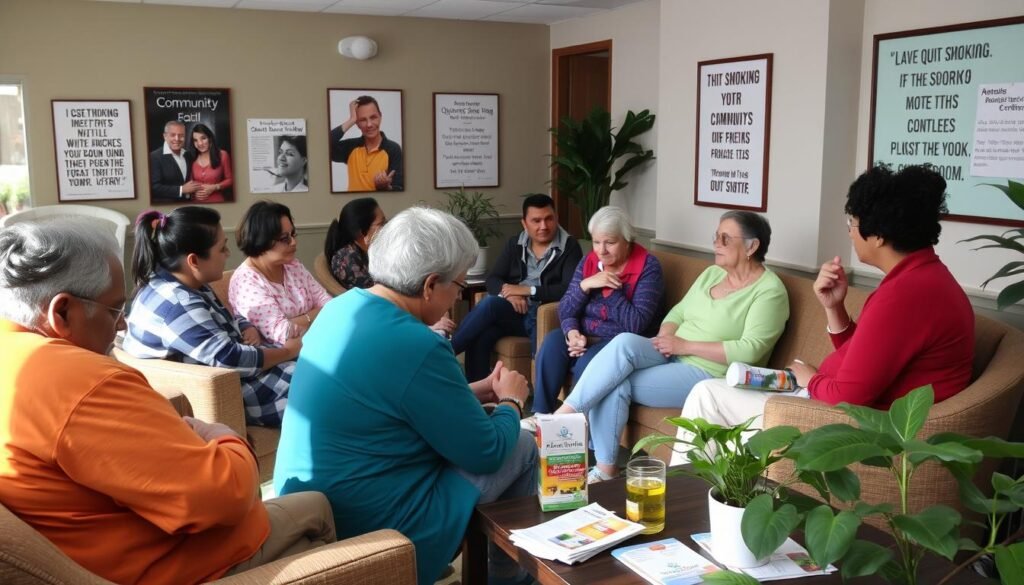About 85% of lung cancer deaths come from smoking. This shows how serious smoking is as the main cause of cancer deaths in the U.S. If you’ve stopped smoking, it’s important to know the Ex-Smoker Lung Cancer Risk. You should also know how to keep your health on track. Stopping smoking is a great health choice. It also lowers the risk of diseases related to smoking.
Stopping smoking helps your lungs get better. But, if you used to smoke, you need to stay alert. Getting checked regularly and talking to doctors about lung cancer risk factors is key. This helps in managing your health better and finding problems early. Knowing how to lower risks after quitting smoking is important for staying healthy for a long time.
With the right information and choices, people who have quit smoking can really improve their health. They can also lower their chances of getting lung cancer and other illnesses from tobacco.
Key Takeaways
- Smoking is responsible for about 85% of lung cancer fatalities.
- Ex-smokers maintain a higher cancer risk compared to never-smokers, even decades after quitting.
- Regular health screenings are vital for former smokers to monitor lung health.
- Quitting smoking leads to significant long-term benefits and risk reduction.
- Honest communication with healthcare providers can optimize cancer risk management.
Understanding the Impact of Smoking on Lung Health
Tobacco use is a major cause of serious health problems, especially for the lungs. Smoking leads to about 90% of lung cancer deaths. It also causes other smoking-related diseases like COPD and heart disease. Knowing the risks is important for everyone.
Health Consequences of Tobacco Use
Smoking causes chronic lung inflammation. This can lead to genetic changes and a higher risk of lung cancer. About 80% of COPD deaths are from smoking. Chronic lung diseases affect 73% of smokers. Most smokers start young, with 94% trying cigarettes by age 21. Starting early increases the risk to lung health.
Statistics on Lung Cancer and Smoking
The stats on lung cancer show how serious smoking is. In 2021, 11.5% of U.S. adults smoked. This is the lowest rate since 1965. Yet, smoking is still the top cause of lung cancer. Roughly 40-50% of lung cancer patients were smoking when diagnosed. About half quit after finding out. Knowing these stats is key to quitting smoking. For more info, read this research article.
| Statistic | Percentage/Rate |
|---|---|
| Lung cancer deaths attributable to smoking | 90% |
| Deaths from COPD caused by smoking | 80% |
| Current adults who smoke (2021) | 11.5% |
| Adults living with chronic lung diseases | 73% |
| Young adults who first smoked by age 21 | 94% |
| Former smokers in the U.S. (2017) | 55.2 million |
Ex-Smoker Lung Cancer Risk: An Overview
For anyone who has stopped smoking, knowing the risk of lung cancer is key. Quitting smoking early, especially before 40, has big benefits for how long you might live. Stopping smoking reduces the chance of getting lung cancer and other related diseases. This shows how important this step is for your health.
Longevity Benefits of Quitting Smoking
Stopping smoking has been proven to add years to your life. People who quit by age 40 cut their risk of dying from smoking-related issues by up to 90%. Men who keep smoking have a high risk of lung cancer, which highlights the life-saving choice of quitting. For example, current smokers in the UK have a 16% risk of lung cancer by 75, which is much higher than for those who’ve never smoked.
Comparative Risk Levels: Ex-smokers vs. Never-Smokers
Even though ex-smokers still have a higher risk of lung cancer than those who never smoked, the risk decreases over time. Studies show quitting at 30 or 40 greatly lowers the risk for lung problems. Still, by age 75, ex-smokers have a three times higher risk than never-smokers. This shows why it’s important to keep up with health screenings and talk with your doctor. For more on lung cancer screenings, visit this useful link.
The Timeline of Risk Reduction After Quitting
Quitting smoking starts a journey towards better health, with many changes over time. Knowing this timeline can push people to quit for good. It shows quick health perks and lower cancer risks later on.
Immediate Health Benefits Post-Cessation
Right after quitting, people see big health boosts. These immediate health benefits are:
- Enhanced lung function and improved circulation.
- Decreased heart rate and blood pressure.
- Quicker recovery from respiratory illnesses.
- Improved sense of taste and smell.
This early recovery period leads to more health gains later. It reduces future health risks significantly.
Long-Term Decrease in Cancer Risk
Over time, quitting smoking’s benefits grow. Studies show:
| Duration After Quitting | Risk Reduction in Lung Cancer | Overall Cancer Risk |
|---|---|---|
| 1 Year | ~ 42% lower | 17% lower |
| 5 Years | Over 50% lower | – |
| 10 Years | Approaches nonsmoker levels | – |
| 15 Years | Half the risk of smokers | – |
Stopping smoking cuts cancer risk a lot. Though lung cancer risk drops fast, it’s vital to remember it never matches that of nonsmokers. This decrease shows how the body can heal and why it’s important for former smokers to lower their risks.
Role of Lung Health Screening for Former Smokers
Lung health screening is key for people who used to smoke. It checks for lung cancer. Quitting smoking lowers cancer risk but doesn’t get rid of it. Those who have quit smoking still face health issues related to their past tobacco use. This shows why regular screenings are important. Screenings can spot lung problems early. This often means better chances of getting well.
Why Screening is Essential for Ex-Smokers
Screening for people who used to smoke is very important. Studies show these individuals still have a high risk of getting lung cancer, even 15 years after they quit. Catching it early through screenings can save lives. Plus, these tests use only a bit of radiation now.
- People 50 to 80 years old who smoked a lot should get checked every year.
- Even those who have quit smoking should still get screened because of the cancer risk.
- Finding cancer early can lead to better results.
Recommended Screening Methods and Guidelines
The American Cancer Society gives guidelines for lung screenings. They recommend a CT scan that uses a low dose of radiation. This scan is quick, doesn’t hurt, and is very safe. It’s a good choice for checking your lungs every year.
| Criteria for Lung Health Screening | Details |
|---|---|
| Age | 50 to 80 years old |
| Smoking History | At least 20 pack-years |
| Quit Status | Former smokers or those who quit within the last 15 years |
| Screening Method | Low-dose CT scan |
Ex-smokers should get lung health screenings regularly. These checks are a way to deal with the effects of smoking early. They can make a big difference in how long and how well you live.

Cancer Prevention Strategies for Ex-Smokers
For ex-smokers, it’s key to reduce their lung cancer risk. Making lifestyle changes and getting regular check-ups are vital. These steps improve their health and guard against diseases.
Lifestyle Changes to Reduce Cancer Risk
Ex-smokers can make life changes to fend off cancer. Healthy living lowers death risk by 27% over 19 years, research finds. Adopt these habits:
- Engaging in regular physical activity: This alone leads to a 17% lower risk of death.
- Maintaining a healthy body weight: Achieving this goal can reduce death risk by 14%.
- Improving diet quality: Better nutrition results in a 9% lower risk of death.
- Limiting alcohol intake: This practice contributes to a 4% reduction in risk.
Adding these habits to your routine helps prevent cancer and boosts overall health. Knowing about environmental factors and getting regular check-ups also play a big role in keeping your lungs healthy.
Importance of Regular Health Check-Ups
Check-ups are crucial for ex-smokers. They can catch lung issues early, which improves treatment success. Low-dose CT scans are especially good at finding lung cancer in those who smoked a lot or used to smoke.
Taking these prevention steps can make ex-smokers healthier and lower their cancer risk. For lung cancer prevention tips, check out this resource.
Understanding Second-Hand Smoke Exposure
Second-hand smoke affects lung health, especially for previous smokers. It’s full of harmful chemicals that raise lung cancer risk. Even non-smokers can develop serious respiratory issues from it.
Effects on Former Smokers’ Lung Health
Former smokers face significant risks. Research shows they have a 1.30 times higher chance of getting lung cancer if exposed to second-hand smoke early in life. Continued second-hand smoke can also slow recovery in people who have stopped smoking.
Lung cancer is a leading death cause in the U.S. This makes tackling second-hand smoke exposure vital.
Protective Measures Against Second-Hand Smoke
Ex-smokers need to protect themselves from second-hand smoke. This includes avoiding places where smoking occurs and pushing for smoke-free spaces. Raising awareness about its dangers benefits everyone’s health.
Laws limiting smoke exposure in closed spaces help promote lung health. For detailed health risks of second-hand smoke, click here.

Additional Risk Factors for Lung Cancer
Smoking is often seen as the main cause of lung cancer. But there are other important factors too. These factors also play a big role in the chance of getting lung cancer. It’s key to look at the whole picture to understand risk better.
Role of Age and Family History
Age greatly affects lung cancer risk. Most people are diagnosed around 70 years old. As people get older, they often worry more about lung cancer. Also, having a family history of lung cancer increases risk.
If your parents or siblings had lung cancer, you’re more likely to get it too. Knowing about your family history and age helps in understanding your own risk.
Environmental and Occupational Exposures
Being exposed to harmful substances in the environment also raises lung cancer risk. Radon and asbestos are especially dangerous. For smokers, the risk of lung cancer from radon is even higher.
Jobs that involve dangerous chemicals can be risky as well. Workers dealing with silica, diesel exhaust, and chemicals face a higher lung cancer risk. Living in areas with a lot of air pollution matters too. Knowing these risks is important for everyone, especially those in high-risk places.
Smoking Cessation Benefits and Support Programs
Stopping smoking brings many health benefits, especially for those with lung cancer history. Support programs are key in helping quit smoking. They offer counseling, medication, and structured plans to beat nicotine addiction. Quitting smoking improves survival rates and life quality greatly.
Nicotine Addiction Recovery Resources
Overcoming nicotine addiction is tough, but there are great resources available. Support programs offer a full range of help. Valuable resources include:
- Counseling services offered through hospitals or community health centers encourage discussion and personalized strategies.
- Medications, like nicotine replacements and prescription drugs, ease withdrawal symptoms.
- Quitlines offer immediate phone support from professionals.
- Mobile apps provide round-the-clock encouragement and tracking, aiding your quitting journey.
Quit Smoking Programs and Their Effectiveness
Joining quit smoking programs is crucial for success. Such programs lead to improved long-term health. Studies show that stopping smoking post early lung cancer diagnosis extends life by a median of 22 months versus those who continue. The survival rate benefits include:
| Timeframe | Quit Smoking Survival Rate | Continued Smoking Survival Rate |
|---|---|---|
| 3 Years | 75% | 66% |
| 5 Years | 61% | 49% |
About half of the non-small cell lung cancer patients keep smoking after diagnosis. Yet, 42.5% of those studied managed to quit, although some returned to smoking. Quitting smoking helps slow down the disease’s progress. It increases lifespan and lowers cancer risks. Support programs play a crucial role in beating nicotine addiction and enjoying the benefits of quitting.

Research on Lung Cancer Screening Recommendations
It’s crucial for high-risk individuals to understand lung cancer screening recommendations. The National Lung Screening Trial offers key insights. It shows effective screening, especially for those with a history of smoking. Early detection is very important. The latest guidelines suggest low-dose CT scans are vital for finding lung cancer early.
Current Guidelines for High-Risk Individuals
Now, high-risk adults between 50 to 80 should get a yearly screen. They need a history of 20 pack-years of smoking. This change means nearly 5 million more people in the U.S. could get screened. It helps fill a big gap in stopping lung cancer.
Finding cancer early can really cut down death rates. It makes a huge difference.
Finding a Lung Cancer Screening Program
Finding the right lung cancer screening program is key. Many places work with groups to make screening easy to get to. You should talk with your doctor to see if you’re eligible. They will look at your smoking history, age, and health overall.
A helpful and clear talk with your doctor boosts screening rates. It encourages more people to get checked.
Conclusion
It’s crucial to know the lung cancer risk for those who stopped smoking. Quitting smoking drops lung cancer risk by 39.1% in five years. Still, it’s important to keep up with health check-ups and screenings.
Screenings can cut the risk of dying from lung cancer by 20%. This is big news for everyone’s health.
In the U.S., smoking causes 87% of lung cancer deaths. So, people who’ve smoked should watch their lung health closely. Having a condition like COPD doubles your lung cancer risk. It’s key to make healthy choices and get screened.
Growing older raises the risk of lung cancer. Knowing this, it’s important to quit smoking and stay health-aware. Screenings are also a must for a better future. For more info, check out COPD and lung cancer.